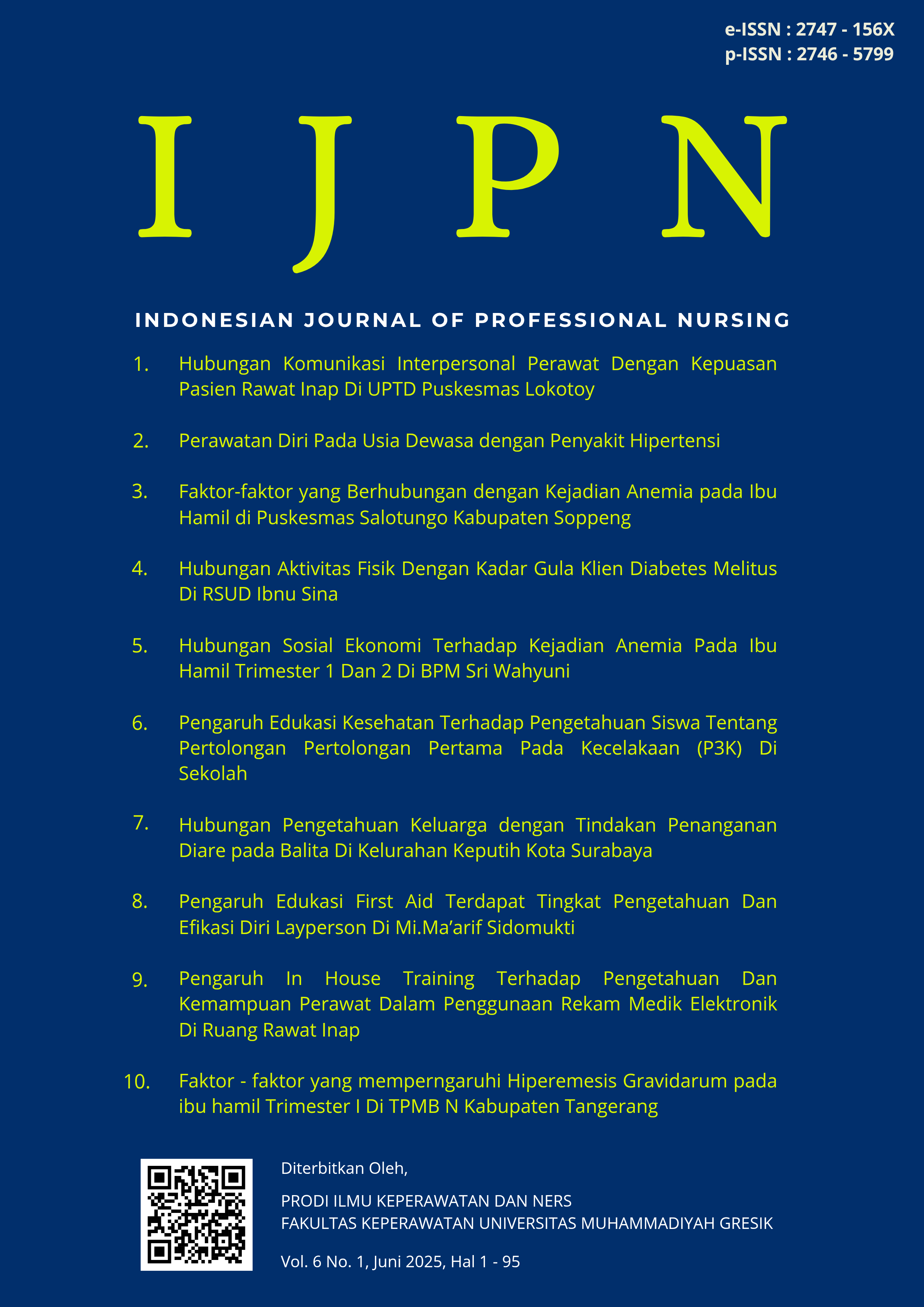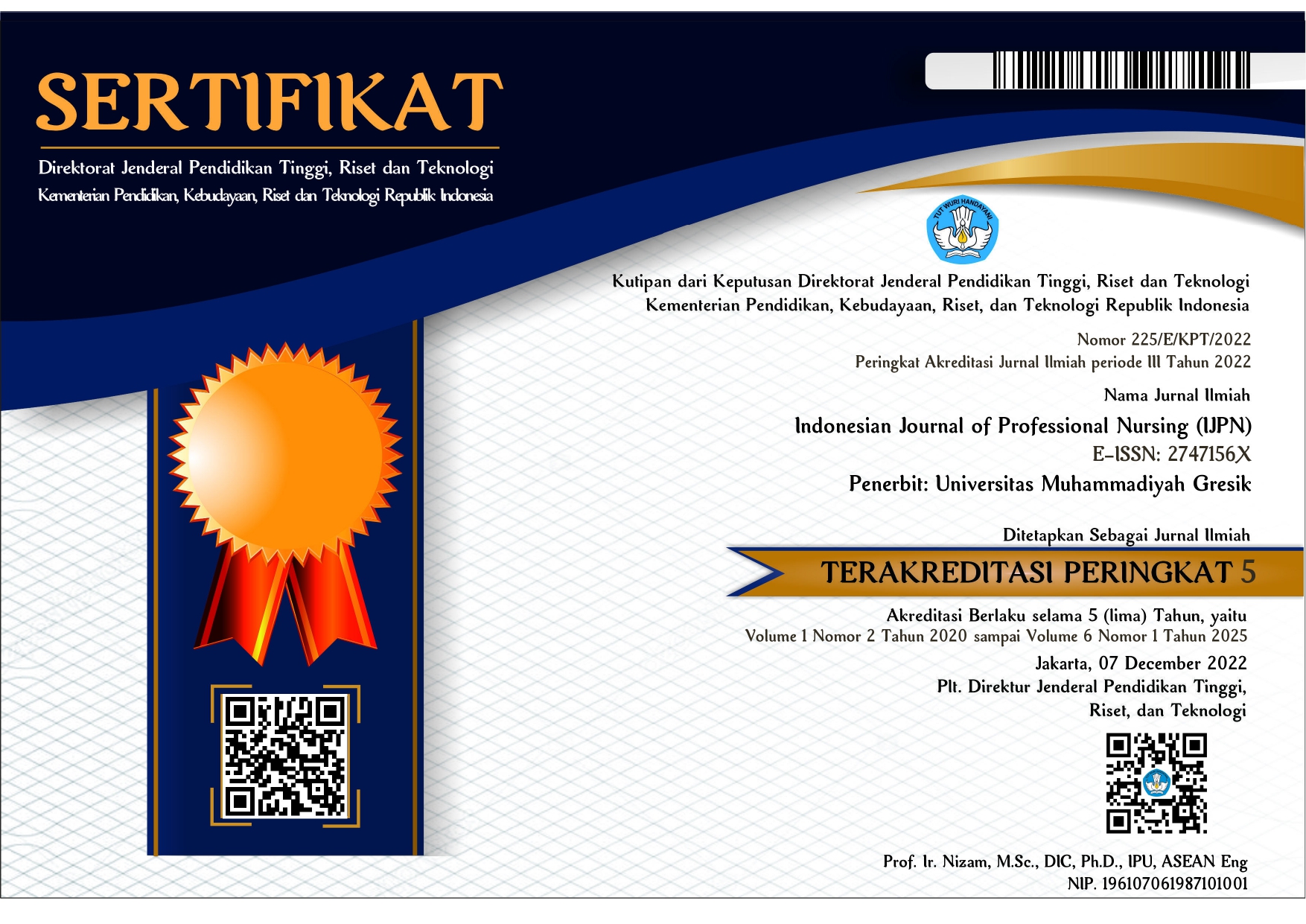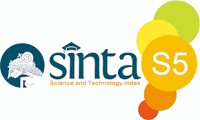Hubungan Sosial Ekonomi Terhadap Kejadian Anemia Pada Ibu Hamil Trimester 1 Dan 2 Di BPM Sri Wahyuni
DOI:
https://doi.org/10.30587/ijpn.v6i1.9633Abstract
Anemia mempunyai dampak negatif pada ibu selama masa kehamilan, selain itu juga berdampak pada neonatus seperti berat bayi lahir rendah atau kelahiran prematur bahkan berdampak pada kematian janin. Penyebab masalah kesehatan pada ibu hamil salah satunya adalah anemia, anemia menjadi masalah kesehatan global di 35 negaraPada faktor sosial ekonomi dan standar hidup yang rendah masih menjadi masalah besar yang dihadapi sebagian besar negara berkembang. Penelitian ini berjenis korelasional dengan desain penelitian cross sectional study. Populasi penelitian ini adalah seluruh ibu hamil di BPM Sri Wahyuni sebanyak 25 orang. Teknik sampling yang digunakan peneliti adalah Total Sampling. Intrumen yang digunakan dalam penelitian ini adalah kuesioner. Analisis data dilakukan dengan menggunakan uji sperman rank dan kendall tau. Hasil uji hipotesis didapatkan ρ value=0.000 < α=0.05 disimpulkan bahwa Ho ditolak, terdapat hubungan antara perkejaan ibu dnegan kejadian anemia. Pendapatan keluarga merupakan faktor risiko terhadap kejadian anemia dikarenakan pendapatan keluarga berpengaruh pada pembelian dan penentuan bahan makanan yang dikonsumsi sehari-hari. Pendidikan erat dengan kemampuan menerima informasi yang berkaitan dengan kesehatan terutama pada ibu hamil anemia, seperti pengetahuan anemia, pemilihan makanan tinggi zat besi dan asupan zat besi. Pekerjaan ibu rumah tangga sangat berat dan pekerjaan di luar rumah yang mengharuskan ibu bekerja cukup lama, hal ini dapat menyebabkan ibu lelah, banyak tekanan, mengganggu jalannya kehamilan, dan dapat menyebabkan anemia.
References
Abd Rahman, R., Idris, I. B., Isa, Z. M., Rahman, R. A., & Mahdy, Z. A. (2022). The Prevalence and Risk Factors of Iron Deficiency Anemia Among Pregnant Women in Malaysia: A Systematic Review. Frontiers in Nutrition, 9(April), 1–9. https://doi.org/10.3389/fnut.2022.847693
Abu-Baker, N. N., Eyadat, A. M., & Khamaiseh, A. M. (2021). The impact of nutrition education on knowledge, attitude, and practice regarding iron deficiency anemia among female adolescent students in Jordan. Heliyon, 7(2). https://doi.org/10.1016/j.heliyon.2021.e06348
Adjei-Banuah, N. Y., Aduah, V. A., Ziblim, S. D., Ayanore, M. A., Amalba, A., & Mogre, V. (2021). Nutrition Knowledge is Associated With the Consumption of Iron Rich Foods: A Survey Among Pregnant Women From a Rural District in Northern Ghana. Nutrition and Metabolic Insights, 14, 1–7. https://doi.org/10.1177/11786388211039427
Agarwal, A. M., & Rets, A. (2021). Laboratory approach to investigation of anemia in pregnancy. International Journal of Laboratory Hematology, 43(S1), 65–70. https://doi.org/10.1111/ijlh.13551
Anand, I. S., & Gupta, P. (2018). Anemia and Iron Deficiency in Heart Failure: Current Concepts and Emerging Therapies. Circulation, 138(1), 80–98. https://doi.org/10.1161/CIRCULATIONAHA.118.030099
Anggraini, H., Mulyani, R. I., Novaria, A. A., & Virawati, D. I. (2024). The Effect of PENEMIA (Prevention of Anemia) Video-Based Education on Anemic Pregnant Women on Changes in Knowledge and Attitudes. Journal of Health and Nutrition Research, 3(1), 31–38. https://doi.org/10.56303/jhnresearch.v3i1.195
Anjelina, E., Lestari, R. M., & Prasida, D. W. (2023). Pengaruh Pendidikan Kesehatan Terhadap Pengetahuan dan Sikap Ibu dalam Pemberian ASI Ekslusif di Wilayah Kerja UPT Puskesmas Marina Permai Kota Palangka Raya Tahun 2022. Jurnal Surya Medika, 9(1), 126–136. https://doi.org/10.33084/jsm.v9i1.5159
Armini, N. K. A., Nursalam, N., & Ikmala, L. S. (2023). Analysis of factors influencing health-related quality of life in HIV/AIDS patients. HIV and AIDS Review, 22(4), 300–304. https://doi.org/10.5114/hivar.2023.133078
Aryastami, N. K., & Mubasyiroh, R. (2023). Optimal utilization of maternal health service in Indonesia: a cross-sectional study of Riskesdas 2018. BMJ Open, 13(9), 1–9. https://doi.org/10.1136/bmjopen-2022-067959
Benly, N. E., & Mansyarif, R. (2022). Knowledge and Attitude of Pregnant Women : A Case Study of Pregnant Women in Muna Regency. 33(1), 11–18. https://doi.org/http://dx.doi.org/10.52155/ijpsat.v33.1.4338
Breunig, R., & Majeed, O. (2020). Inequality, poverty and economic growth. International Economics, 161(May 2020), 83–99. https://doi.org/https://doi.org/10.1016/j.inteco.2019.11.005
Brittenham, G. M., Moir-Meyer, G., Abuga, K. M., Datta-Mitra, A., Cerami, C., Green, R., Pasricha, S. R., & Atkinson, S. H. (2023). Biology of Anemia: A Public Health Perspective. Journal of Nutrition, 153(September), S7–S28. https://doi.org/10.1016/j.tjnut.2023.07.018
Burayu, E. T., & Degefa, B. D. (2024). Exploration of iron deficiency anemia and its associated factors among pregnant women seeking antenatal care in public health facilities of southwestern Ethiopia. A mixed study. AJOG Global Reports, 4(4), 100417. https://doi.org/10.1016/j.xagr.2024.100417
Corchero-Falcón, M. del R., Gómez-Salgado, J., García-Iglesias, J. J., Camacho-Vega, J. C., Fagundo-Rivera, J., & Carrasco-González, A. M. (2023). Risk Factors for Working Pregnant Women and Potential Adverse Consequences of Exposure: A Systematic Review. International Journal of Public Health, 68(February). https://doi.org/10.3389/ijph.2023.1605655
dos Santos, C., de Almeida, J., Saint Arnault, D., Riccio, MCde Oliveira, J., & de Souza, J. (2025). High-risk pregnant women’s perceptions of their condition: A qualitative study with an emphasis on psychosocial need. Transcultural Psychiatry, Januari 22(0). https://doi.org/10.1177/13634615241296298
Efendi, F., Israfil, I., Ramadhan, K., McKenna, L., Alem, A. Z., & Malini, H. (2023). Factors associated with receiving iron supplements during pregnancy among women in Indonesia. Electronic Journal of General Medicine, 20(5), 1–7. https://doi.org/10.29333/ejgm/13266
Engidaw, M. T., Eyayu, T., & Tiruneh, T. (2022). The effect of maternal anaemia on low birth weight among newborns in Northwest Ethiopia. Scientific Reports, 12(1), 1–8. https://doi.org/10.1038/s41598-022-19726-z
Hidayatunnikmah, N. (2021). Level of education, knowledge of pregnant women regarding iron tablets to compliance with their consumption. Jurnal Kesehatan LLDikti Wilayah 1 (JUKES), 1(1), 15–21. https://doi.org/10.54076/jukes.v1i1.126
Jouanne, M., Oddoux, S., Noël, A., & Voisin-Chiret, A. S. (2021). Nutrient requirements during pregnancy and lactation. Nutrients, 13(2), 1–17. https://doi.org/10.3390/nu13020692
Karemoi, T. M., Mardiah, W., & Adistie, F. (2020). Factors Affecting Nutritional Status of Pregnant Women. Asian Community Health Nursing Research, 2(2), 39. https://doi.org/10.29253/achnr.2020.23958
Kleebbua, C., & Siriparp, T. (2016). Effects of Education and Attitude on Essential Learning Outcomes. Procedia - Social and Behavioral Sciences, 217, 941–949. https://doi.org/10.1016/j.sbspro.2016.02.061
Kusumajaya, A. A. N., Sudikno, R. M. S., Nainggolan, O., Nursanyoto, H., Sutiari, N. K., Adhi, K. T., Suarjana, I. M., & Januraga, P. P. (2023). Sociodemographic and Healthcare Factors Associated with Stunting in Children Aged 6–59 Months in the Urban Area of Bali Province, Indonesia 2018. Nutrients, 15(2), 389. https://doi.org/https://doi.org/10.3390/nu15020389
Mangalik, G., Wijayanti, D. B. S., & Tampubolon, R. (2023). Evaluasi Konsumsi Makan dan Kepatuhan Konsumsi TTD terhadap Tingkat Kecukupan Zat Besi pada Remaja Putri di SMKN 1 Salatiga. Jurnal Epidemiologi Kesehatan Komunitas, 8(2), 171–181. https://doi.org/10.14710/jekk.v8i2.12824
Munira, L., & Viwattanakulvanid, P. (2024). Knowledge, attitude, and practice towards anemia prevention among female students in Indonesia: a mixed method study. International Journal of Evaluation and Research in Education , 13(1), 371–378. https://doi.org/10.11591/ijere.v13i1.25750
Murphy, R., Marshall, K., Zagorin, S., Devarshi, P. P., & Hazels Mitmesser, S. (2022). Socioeconomic Inequalities Impact the Ability of Pregnant Women and Women of Childbearing Age to Consume Nutrients Needed for Neurodevelopment: An Analysis of NHANES 2007–2018. Nutrients, 14(18). https://doi.org/10.3390/nu14183823
Oktaviani, O., & Ayue, H. I. (2021). Pendidikan Kesehatan pada Ibu Hamil tentang Anemia menggunakan Media Video di Kota Palangka Raya. PengabdianMu: Jurnal Ilmiah Pengabdian Kepada Masyarakat, 6(6), 558–561. https://doi.org/10.33084/pengabdianmu.v6i6.2104
Oyelese, A. T., Ogbaro, D. D., Wakama, T. T., Adediran, A., Gbadegesin, A., Awodele, I. O., Ocheni, S., Adetola, A., & Adenuga, J. O. (2021). Socio-economic determinants of prenatal anaemia in rural communities of South-West Nigeria: a preliminary report. American Journal of Blood Research, 11(4), 410–416. http://www.ncbi.nlm.nih.gov/pubmed/34540350%0Ahttp://www.pubmedcentral.nih.gov/articlerender.fcgi?artid=PMC8446826
Prasetyo, Y. B., Permatasari, P., & Susanti, H. D. (2023). The effect of mothers’ nutritional education and knowledge on children’s nutritional status: a systematic review. International Journal of Child Care and Education Policy, 17(1). https://doi.org/10.1186/s40723-023-00114-7
Sabina Azhar, B., Islam, M. S., & Karim, M. R. (2021). Prevalence of anemia and associated risk factors among pregnant women attending antenatal care in Bangladesh: A cross-sectional study. Primary Health Care Research and Development, 22(e61), 1–10. https://doi.org/10.1017/S146342362100061X
Shah, S. A., Soomro, U., Ali, O., Tariq, Y., Waleed, M. S., Guntipalli, P., & Younus, N. (2023). The Prevalence of Anemia in Working Women. Cureus, 15(8), 1–8. https://doi.org/10.7759/cureus.44104
Soma-Pillay, P., Nelson-Piercy, C., Tolppanen, H., & Mebazaa, A. (2016). Physiological changes in pregnancy. Cardiovascular Journal of Africa, 27(2), 89–94. https://doi.org/10.5830/CVJA-2016-021
Souganidis, E., Sun, K., Pee, S. de, Kraemer, K., Rah, J.-H., Pfanner, R. M., Sari, M., Bloem, M. W., & Semba, R. (2014). among families in Indonesia. 16(9), 1913–1925. https://doi.org/10.1007/s10995-011-0938-y.Relationship
Stephen, G., Mgongo, M., Hussein Hashim, T., Katanga, J., Stray-Pedersen, B., & Msuya, S. E. (2018). Anaemia in Pregnancy: Prevalence, Risk Factors, and Adverse Perinatal Outcomes in Northern Tanzania. Anemia, 2018. https://doi.org/10.1155/2018/1846280
Talin, I. A., Abid, M. H., Samad, M. A., Domínguez Azpíroz, I., de la Torre Diez, I., Ashraf, I., & Nahid, A. Al. (2023). Exploring factors influencing the severity of pregnancy anemia in India: a study using proportional odds model.










